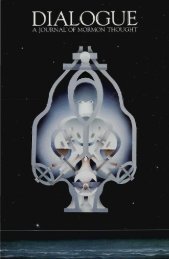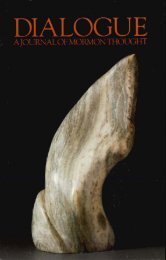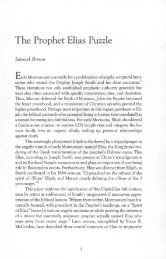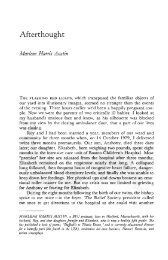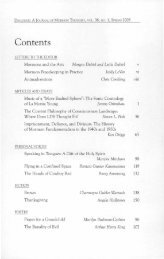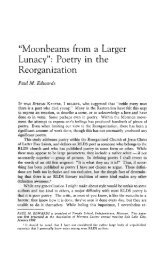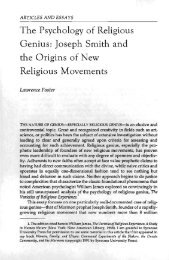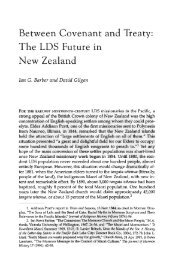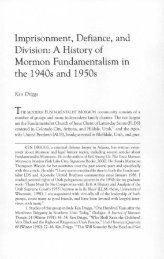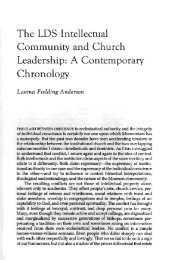Dialogue, Volume 25, Number 2 - Dialogue – A Journal of Mormon ...
Dialogue, Volume 25, Number 2 - Dialogue – A Journal of Mormon ...
Dialogue, Volume 25, Number 2 - Dialogue – A Journal of Mormon ...
Create successful ePaper yourself
Turn your PDF publications into a flip-book with our unique Google optimized e-Paper software.
168 DIALOGUE: A JOURNAL OF MORMON THOUGHT<br />
Amana Society <strong>of</strong> Amana, Iowa, are<br />
descended originated in 1714. Nevertheless,<br />
the term "new religious movement"<br />
is certainly less pejorative than "cult" or<br />
"sect," the traditional sectarian terms.<br />
The authors <strong>of</strong> the book's essays demonstrate<br />
that none <strong>of</strong> the new religious<br />
movements discussed, with the exception<br />
<strong>of</strong> the Spirit Fruit Society, self-destructed<br />
after the death <strong>of</strong> their founders. Nevertheless,<br />
the groups enjoyed varying<br />
degrees <strong>of</strong> success. For example, <strong>of</strong> the<br />
movements discussed, the Latter-day<br />
Saints have enjoyed the greatest growth<br />
in membership. Without taking into<br />
account the various splinter groups, which<br />
Melton claims are now in excess <strong>of</strong> fifty,<br />
there are now more than 7.7 million<br />
Latter-day Saints worldwide. According to<br />
a 15 September 1991 New York Times article,<br />
this means that there are "now more<br />
<strong>Mormon</strong>s than members <strong>of</strong> the Presbyterian<br />
Church (U.S.A.) or the Episcopal<br />
Church, two pillars <strong>of</strong> the religious<br />
establishment." In other words, a "new<br />
religious movement" now outnumbers<br />
other "mainstream Christian churches," at<br />
least in the United States. This same<br />
article points out that only one other religion<br />
challenges <strong>Mormon</strong>ism for new converts:<br />
the Jehovah Witnesses, another<br />
nineteenth-century American religion.<br />
Most new religious movements have<br />
not been so successful in attracting new<br />
members. Statistics cited in the third edition<br />
<strong>of</strong> J. Gordon Melton's Encyclopedia <strong>of</strong><br />
American Religion published in 1989 demonstrate<br />
that the Hutterites have approximately<br />
353 communities, the Shakers<br />
have only seven members, the Amana<br />
Society 1,141, the Theosophical Society<br />
approximately 34,000, the Rastafari <strong>of</strong><br />
Jamaica between 3,000 and 5,000, the<br />
Krishna Consciousness approximately<br />
8,000, and the Unification Church and<br />
Christian Science in the hundreds <strong>of</strong> thousands.<br />
Thus, while the essays demonstrate<br />
that the movements studied have not died<br />
with their founders, such survival is no<br />
guarantee that the religions have grown<br />
and prospered.<br />
Of particular interest to readers <strong>of</strong><br />
DIALOGUE is Steven L. Shields's essay,<br />
"The Latter-day Saint Movement: A<br />
Study in Survival." Shields has written<br />
several books about religions in the <strong>Mormon</strong><br />
family, the most comprehensive<br />
being Divergent Paths <strong>of</strong> the Restoration (Los<br />
Angeles, Calif.: Restoration Research,<br />
1990). Though this essay does not break<br />
any new ground in historic research, it<br />
does survey the early history <strong>of</strong> Joseph<br />
Smith, the succession in the presidency,<br />
and the various religious groups which<br />
arose following his death, including the<br />
Church <strong>of</strong> Jesus Christ <strong>of</strong> Latter-day<br />
Saints, the Reorganized Church <strong>of</strong> Jesus<br />
Christ <strong>of</strong> Latter Day Saints, the<br />
Strangites, the Cutlerites, the Bickertonites,<br />
and the Hedrickites.<br />
At times, Shields' terminology seems<br />
more appropriate for a lawyer's brief. For<br />
example, when discussing the succession<br />
claims <strong>of</strong> Brigham Young and the Quorum<br />
<strong>of</strong> the Twelve, he refers to their<br />
"alleged designation" by Joseph Smith<br />
(p. 61), the "alleged" conferring <strong>of</strong> the<br />
keys <strong>of</strong> the kingdom to the Quorum <strong>of</strong><br />
the Twelve (p. 61); when discussing the<br />
practice <strong>of</strong> polygamy, he refers to the<br />
"alleged participants" in that practice<br />
(p. 64). He uses no such terminology<br />
when he discusses Joseph Smith Ill's designation<br />
as successor: "Joseph Smith, III<br />
had been designated as his father's successor<br />
on at least four different occasions"<br />
(p. 61).<br />
In addition, he does not discuss the<br />
current condition <strong>of</strong> the various church<br />
organizations which originated after<br />
Smith's death. Recent membership statistics<br />
indicate that there are fewer than<br />
two hundred Strangites, forty Cutlerites,<br />
and three thousand Bickertonites and<br />
Hedrickites. Thus, while it is certainly<br />
true that many churches claim their<br />
authority through Joseph Smith, no more<br />
than two have any significant following.<br />
Although this book provides limited<br />
examples <strong>of</strong> what happens after "prophets<br />
die" and makes little effort to distinguish<br />
between survival and growth, it is



